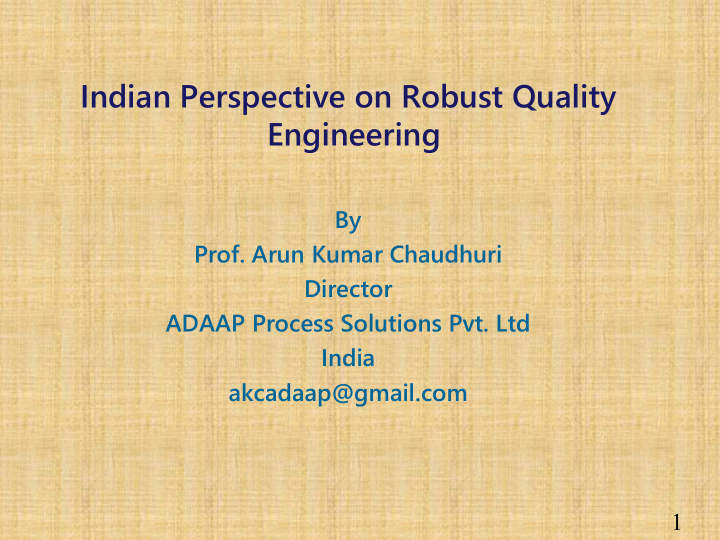



Indian Perspective on Robust Quality Engineering By Prof. Arun Kumar Chaudhuri Director ADAAP Process Solutions Pvt. Ltd India akcadaap@gmail.com 1
• Background • Application Status of RQE in India • Our approach towards RQE application • Benefits of RQE approach 2
The Need 3
Early Panoramic View 4
Early Applications of DOE • Started around Mid-1970 , pioneers : BHEL, Kirloskars, a few Small industries at Bangalore • Trained Engineers on Taguchi’s DOE but not Managers with a few exceptions • Late S L Kirloskar himself attended a Program on DOE. His Curiosity knew no bounds • Later Mr. Venu Srinivasan of TVS also took an intensive training on Application of DOE • Typical areas of applications: Yield Improvement using optimization of process parameters (Insulator), Existing product design optimization to reduce cost (Pump),Reliability improvement of Circuit Breakers, etc 5
Contd 6
7
Signal to Noise Ratio • With S/N ratio we get a combined measure of average and variation which is not the case in any other approach • RQE approach helps us to optimize the output keeping minimum variability thus maximizing robustness. • S/N ratio has very good additive capability in quality evaluation and prediction • Taguchi pointed out that one of the advantages of using S/N ratio is its direct link with economy; as S/N ratio is deduced from loss function • Cost advantage as only few selected combination trails are run 8 • STATIC VS DYNAMIC
Melting of Frozen Ice 9
Service Processes • They also included service functions like logistics, SCM, Finance to improve robustness with astounding resultss • The IT/ITES did not fall behind with human dominant processes • RBEI, L&T,Wipro, Capgemini ,came up with a few novel applications • Universal applicability was shown by CPG when for DMAIC/DFSS Project , they are comparing S/N Ratio before and after • All said and done just surface scrtching has started. • Let’s discuss how to take it forward ! • We need trainers, guides and coaches-Can You Help? 10
Recommend
More recommend